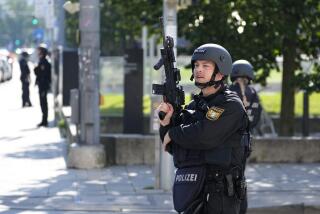Britain Reveals Plot to Kill Hitler
- Share via
LONDON — British agents plotted to kill Adolf Hitler at his Bavarian retreat in Berchtesgaden in the final months of World War II, but internal debate and the search for the right assassin kept them from an attempt before the Fuehrer took his own life April 30, 1945.
Wartime documents released by the British government for the first time Thursday reveal that a sniper attack on Hitler during his morning walk, poison in his tea and milk, and a suitcase full of explosives under his train were among methods considered in the project code-named “Operation Foxley.”
Anthony Eden, then British foreign secretary, approved the idea of an assassination attempt and told Prime Minister Winston Churchill, according to the records of the Special Operations Executive, or SOE, a secret organization set up to promote sabotage in enemy countries.
Arguing that Hitler was regarded by many Germans as “something more than human,” Air Vice Marshal A. P. Ritchie was among the advocates of assassination. “It is this mystical hold which he exercises over the German people that is largely responsible for keeping the country together at the present time,” Ritchie said. “Remove Hitler and there is nothing left.”
But others felt Hitler was more valuable alive than dead.
“As a strategist, Hitler has been of the greatest possible assistance to the British war effort,” said an officer identified as Maj. Field-Robertson, who was referring to Hitler’s miscalculations in strategy. “I have no hesitation in saying that his value to us has been the equivalent to an almost unlimited number of first-class SOE agents strategically placed inside Germany.”
Still, others feared that assassination would turn Hitler into a martyr. The head of SOE’s German section, referred to as “X” but known to be Lt. Col. R. H. Thornley, warned that Germans would “canonize” Hitler. He said it would be “disastrous” if Germans believed that the Allies had to resort to murder because they were unable to defeat the German military machine.
The documents were released by the Public Records Office under a government policy to open security files that are more than 30 years old. Over the last five years, the government has released other World War II records revealing, for example, that the British military had captured the Nazis’ “enigma machine,” enabling the Allies to decipher German coded messages throughout much of the war.
The latest files outlined several SOE sabotage plots, such as the forgery of German stamps with the face of SS chief Heinrich Himmler to encourage rumors that Himmler planned a coup against Hitler and had ordered the stamps to be issued. Agents in Germany used the stamps on letters sent to neutral European countries, and eventually a Swiss newspaper did report speculation about a coup attempt. In response, German authorities issued a statement saying the stamps had been published erroneously.
The idea for assassinating Hitler originated with a tip to the SOE’s office in Algiers in June 1944, suggesting there might be a chance while Hitler was at a chateau in Perpignan, southern France. That information was not acted on, but it prompted Maj. Gen. Colin Gubbins, head of the SOE, to call a meeting of his senior staff.
After much debate, they decided to proceed with planning Operation Foxley and sought the help of “C”--the head of British intelligence, Stewart Menzies--in “keeping track of the gentleman.”
The SOE produced a 120-page report in October 1944 with exhaustive details of Hitler’s habits and movements that included maps, sketches and photographs of his mountain hide-out.
The information, much of which is believed to have been gathered from a prisoner who had served as Hitler’s valet, focused on his morning routine: “Hitler is a late riser, never getting up before 0900 or 1000 hours,” the report said. “He is first seen by his barber, after which he either goes for his morning walk to the Teehaus on the Mooslaner Kopf or attends a conference.”
It said Hitler walked alone, “strolling in a fairly leisurely manner. The walk takes 15 to 20 minutes at normal pace. There is an SS guard at each end and SS patrol (one man) patrolling the route at a discreet distance. Hitler cannot bear to feel himself watched. When Hitler arrives at the Teehaus he takes breakfast which normally consists of milk and toast.”
The report said a sniper could take out Hitler with a high-powered rifle as he took his morning walk or with a bazooka as he rode back in his car.
Alternatively, it suggested derailing Hitler’s train by blasting the track as it went through a tunnel or throwing a suitcase of explosives off the platform as it went through a station. Another option was aerial bombardment of Berchtesgaden, with a special forces battalion parachuted in to combat the 260 or so defenders of the retreat and kill Hitler.
Or there was poison: “Hitler, according to reliable information, is a tea addict. He always drinks it with milk. Since the milk is poured first into the cup, it is unlikely that the tea’s opalescence would be noticed as it came from the teapot.”
By spring 1945, the SOE was looking for a killer and cabled New York on March 16 to find out if British army Capt. Edmund Hailey Bennett, a military attache at the British Embassy in Washington, might be available for a dangerous job. It does not say why he was selected. But on March 26, another cable from London said, “Under present circumstances we do not feel justified in applying for this officer. May revert later.”
A British attempt on Hitler’s life was never made. A little more than a month later, Hitler took his own life at the side of his lover, Eva Braun.
More to Read
Sign up for Essential California
The most important California stories and recommendations in your inbox every morning.
You may occasionally receive promotional content from the Los Angeles Times.













